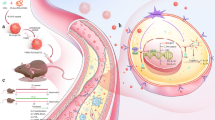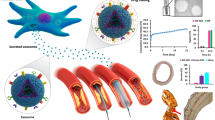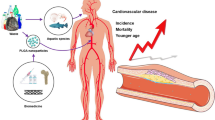Abstract
Purpose
Using a combination of paclitaxel (PTX), and the apoptotic signaling molecule, C6-ceramide (CER), the enhancement in anti-proliferative effect of human aortic smooth muscle cells (SMC) was examined by administering in polymeric nanoparticles.
Methods
PTX- and CER-loaded poly(ethylene oxide)-modified poly(epsilon caprolactone) (PEO-PCL) nanoparticles were formulated by solvent displacement and characterized. The uptake and intracellular localization of the nanoparticle in SMC was examined using Z-stack fluorescent confocal microscopy. Anti-proliferative and pro-apoptotic effects of SMC were determined upon administration of PTX and CER, either as single agent or in combination, in aqueous solution and in PEO-PCL nanoparticle formulations.
Results
High encapsulation efficiencies (i.e., >95%) of PTX and CER at 10% (w/w) loading were attained in the PEO-PCL nanoparticles of around 270 nm in diameter. Fluorescence confocal analysis showed that nanoparticle delivery did facilitate cellular uptake and internalization. Additionally, combination of PTX and CER delivery in PEO-PCL nanoparticles was significantly more effective in decreasing the proliferation of SMC, probably by enhancing the apoptotic response.
Conclusions
The results of this study show that combination of PTX and CER when administered in PEO-PCL nanoparticles can significantly augment the anti-proliferative effect in SMC. This strategy may potentially be useful in the treatment of coronary restenosis.






Similar content being viewed by others
References
G. Dangas, and F. Kuepper. Cardiology patient page. Restenosis: repeat narrowing of a coronary artery: prevention and treatment. Circulation. 105:2586–2587 (2002).
T. Uwatoku, H. Shimokawa, K. Abe, Y. Matsumoto, T. Hattori, K. Oi, T. Matsuda, K. Kataoka, and A. Takeshita. Application of nanoparticle technology for the prevention of restenosis after balloon injury in rats. Circ. Res. 92:e62–e69 (2003).
K. Ganesan, and B. Balram. Prevention of restenosis after coronary angioplasty [Prevention]. Curr. Opin. Cardiol. 19:500–509 (2004).
S. L. Goldberg, A. Loussararian, J. De Gregorio, C. Di Mario, R. Albiero, and A. Colombo. Predictors of diffuse and aggressive intra-stent restenosis. J. Am. Coll. Cardiol. 37:1019–1025 (2001).
M. Bennett. In-stent stenosis: pathology and implications for the development of drug eluting stents. Heart (BMJ). 89:218–224 (2003).
F. Airoldi, C. Di Mario, G. Stankovic, C. Briguori, E. Bramucci, B. Reimers, D. Ardissino, E. Aurier, D. Tavano, and A. Colombo. Effectiveness of treatment of in-stent restenosis with an 8-French compatible atherectomy catheter. Am. J. Cardiol. 92:725–728 (2003).
J. Sharma, R. Kashyap, and A. Sharma. Restenosis following percutaneous transluminal coronary angioplasty among aircrew during intermediate and long term follow up. Ind. J. Aerospace Med. 47:17–22 (2003).
H. J. Rapold, P. R. David, P. Guiteras Val, A. L. Mata, P. A. Crean, and M. G. Bourassa. Restenosis and its determinants in first and repeat coronary angioplasty. Eur. Heart J. 8:575–586 (1987).
M. A. Costa, and D. I. Simon. Molecular basis of restenosis and drug-eluting stents. Circulation. 111:2257–2273 (2005).
F. G. Welt, and C. Rogers. Inflammation and restenosis in the stent era. Arterioscler. Thromb. Vasc. Biol. 22:1769–1776 (2002).
C. P. Regan, P. J. Adam, C. S. Madsen, and G. K. Owens. Molecular mechanisms of decreased smooth muscle differentiation marker expression after vascular injury. J. Clin. Invest. 106:1139–1147 (2000).
S. V. Ranade, K. M. Miller, R. E. Richard, A. K. Chan, M. J. Allen, and M. N. Helmus. Physical characterization of controlled release of paclitaxel from the TAXUS Express2 drug-eluting stent. J. Biomed. Mater. Res. A. 71:625–634 (2004).
J. D. Adams, K. P. Flora, B. R. Goldspiel, J. W. Wilson, S. G. Arbuck, and R. Finley. Taxol: a history of pharmaceutical development and current pharmaceutical concerns. J. Natl. Cancer Inst. Monogr. 15:141–147 (1993).
M. Pennati, A. J. Campbell, M. Curto, M. Binda, Y. Cheng, L. Z. Wang, N. Curtin, B. T. Golding, R. J. Griffin, I. R. Hardcastle, A. Henderson, N. Zaffaroni, and D. R. Newell. Potentiation of paclitaxel-induced apoptosis by the novel cyclin-dependent kinase inhibitor NU6140: a possible role for survivin down-regulation. Mol. Cancer. Ther. 4:1328–1337 (2005).
S. J. Sollott, L. Cheng, R. R. Pauly, G. M. Jenkins, R. E. Monticone, M. Kuzuya, J. P. Froehlich, M. T. Crow, E. G. Lakatta, E. K. Rowinsky, et al. Taxol inhibits neointimal smooth muscle cell accumulation after angioplasty in the rat. J. Clin. Invest. 95:1869–1876 (1995).
C. Herdeg, M. Oberhoff, A. Baumbach, A. Blattner, D. I. Axel, S. Schroder, H. Heinle, and K. R. Karsch. Local paclitaxel delivery for the prevention of restenosis: biological effects and efficacy in vivo. J. Am. Coll. Cardiol. 35:1969–1976 (2000).
D. I. Axel, W. Kunert, C. Goggelmann, M. Oberhoff, C. Herdeg, A. Kuttner, D. H. Wild, B. R. Brehm, R. Riessen, G. Koveker, and K. R. Karsch. Paclitaxel inhibits arterial smooth muscle cell proliferation and migration in vitro and in vivo using local drug delivery. Circulation. 96:636–645 (1997).
R. Kolesnick. The therapeutic potential of modulating the ceramide/sphingomyelin pathway. J. Clin. Invest. 110:3–8 (2002).
F. D. Kolodgie, A. Farb, and R. Virmani. Local delivery of ceramide for restenosis: is there a future for lipid therapy? Circ. Res. 87:264–267 (2000).
R. Charles, L. Sandirasegarane, J. Yun, N. Bourbon, R. Wilson, R. P. Rothstein, S. W. Levison, and M. Kester. Ceramide-coated balloon catheters limit neointimal hyperplasia after stretch injury in carotid arteries. Circ. Res. 87:282–288 (2000).
C. E. Chalfant, B. Ogretmen, S. Galadari, B. J. Kroesen, B. J. Pettus, and Y. A. Hannun. FAS activation induces dephosphorylation of SR proteins; dependence on the de novo generation of ceramide and activation of protein phosphatase 1. J. Biol. Chem. 276:44848–44855 (2001).
L. Brito, and M. Amiji. Nanoparticulate carriers for the treatment of coronary restenosis. Int. J. Nanomed. 2:143–161 (2007).
V. Labhasetwar, C. Song, W. Humphrey, R. Shebuski, and R. J. Levy. Arterial uptake of biodegradable nanoparticles: effect of surface modifications. J. Pharm. Sci. 87:1229–1234 (1998).
C. Song, V. Labhasetwar, X. Cui, T. Underwood, and R. J. Levy. Arterial uptake of biodegradable nanoparticles for intravascular local drug delivery: results with an acute dog model. J. Control Release. 54:201–211 (1998).
U. Westedt, L. Barbu-Tudoran, A. K. Schaper, M. Kalinowski, H. Alfke, and T. Kissel. Deposition of nanoparticles in the arterial vessel by porous balloon catheters: localization by confocal laser scanning microscopy and transmission electron microscopy. AAPS Pharm. Sci. 4:E41 (2002).
S. Mukherjee, R. N. Ghosh, and F. R. Maxfield. Endocytosis. Physiol. Rev. 77:759–803 (1997).
J. Gruenberg. The endocytic pathway: a mosaic of domains. Nat. Rev. Mol. Cell. Biol. 2:721–730 (2001).
L. Pelkmans, and A. Helenius. Endocytosis via caveolae. Traffic. 3:311–320 (2002).
S. B. Sieczkarskiand, and G. R. Whittaker. Dissecting virus entry via endocytosis. J. Gen. Virol. 83:1535–1545 (2002).
S. A. Mousavi, L. Malerod, T. Berg, and R. Kjeken. Clathrin-dependent endocytosis. Biochem. J. 377:1–16 (2004).
H. Cohen-Sacks, Y. Najajreh, V. Tchaikovski, G. Gao, V. Elazer, R. Dahan, I. Gati, M. Kanaan, J. Waltenberger, and G. Golomb. Novel PDGFbetaR antisense encapsulated in polymeric nanospheres for the treatment of restenosis. Gene. Ther. 9:1607–1616 (2002).
H. Suh, B. Jeong, R. Rathi, and S. W. Kim. Regulation of smooth muscle cell proliferation using paclitaxel-loaded poly(ethylene oxide)–poly(lactide/glycolide) nanospheres. J. Biomed. Mater. Res. 42:331–338 (1998).
G. M. Lanza, X. Yu, P. M. Winter, D. R. Abendschein, K. K. Karukstis, M. J. Scott, L. K. Chinen, R. W. Fuhrhop, D. E. Scherrer, and S. A. Wickline. Targeted antiproliferative drug delivery to vascular smooth muscle cells with a magnetic resonance imaging nanoparticle contrast agent: implications for rational therapy of restenosis. Circulation. 106:2842–2847 (2002).
L. E. van Vlerken, Z. Duan, M. V. Seiden, and M. M. Amiji. Modulation of intracellular ceramide using polymeric nanoparticles to overcome multidrug resistance in cancer. Cancer Res. 67:4843–4850 (2007).
J. S. Chawla, and M. M. Amiji. Biodegradable poly(epsilon-caprolactone) nanoparticles for tumor-targeted delivery of tamoxifen. Int. J. Pharm. 249:127–138 (2002).
J. S. Chawla, and M. M. Amiji. Cellular uptake and concentrations of tamoxifen upon administration in poly(epsilon-caprolactone) nanoparticles. AAPS Pharm. Sci. 5:E3 (2003).
L. K. Shah, and M. M. Amiji. Intracellular delivery of saquinavir in biodegradable polymeric nanoparticles for HIV/AIDS. Pharm. Res. 23:2638–2645 (2006).
D. Shenoy, S. Little, R. Langer, and M. Amiji. Poly(ethylene oxide)-modified poly(beta-amino ester) nanoparticles as a pH-sensitive system for tumor-targeted delivery of hydrophobic drugs: part 2. In vivo distribution and tumor localization studies. Pharm. Res. 22:2107–2114 (2005).
M. S. Chun, S. Y. Lee, and S. M. Yang. Estimation of zeta potential by electrokinetic analysis of ionic fluid flows through a divergent microchannel. J. Colloid. Interface Sci. 266:120–126 (2003).
S. Nsereko, and M. Amiji. Localized delivery of paclitaxel in solid tumors from biodegradable chitin microparticle formulations. Biomaterials. 23:2723–2731 (2002).
R. T. Liggins, and H. M. Burt. Paclitaxel-loaded poly(L-lactic acid) microspheres 3: blending low and high molecular weight polymers to control morphology and drug release. Int. J. Pharm. 282:61–71 (2004).
M. Zaffaroni, R. Frapolli, T. Colombo, R. Fruscio, E. Bombardelli, P. Morazzoni, A. Riva, M. D’Incalci, and M. Zucchetti. High-performance liquid chromatographic assay for the determination of the novel C-Seco-taxane derivative (IDN 5390) in mouse plasma. J. Chromatogr. B Analyt. Technol. Biomed. Life Sci. 780:93–98 (2002).
H. Devalapally, Z. Duan, M. V. Seiden, and M. M. Amiji. Paclitaxel and ceramide co-administration in biodegradable polymeric nanoparticulate delivery system to overcome drug resistance in ovarian cancer. Int. J. Cancer. 121:1830–1838 (2007).
Author information
Authors and Affiliations
Corresponding author
Rights and permissions
About this article
Cite this article
Deshpande, D., Devalapally, H. & Amiji, M. Enhancement in Anti-proliferative Effects of Paclitaxel in Aortic Smooth Muscle Cells upon Co-administration with Ceramide using Biodegradable Polymeric Nanoparticles. Pharm Res 25, 1936–1947 (2008). https://doi.org/10.1007/s11095-008-9614-3
Received:
Accepted:
Published:
Issue Date:
DOI: https://doi.org/10.1007/s11095-008-9614-3




